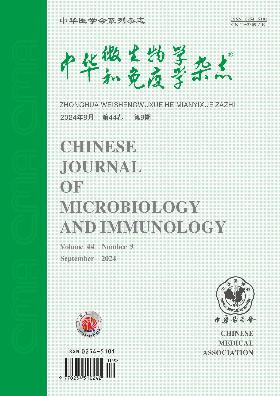2009 - 2018年江苏省流行EV71株流行病学及遗传特征分析
Q4 Immunology and Microbiology
引用次数: 0
摘要
目的分析江苏省2009-2018年肠道病毒71株的分子流行病学、遗传变异及进化情况。方法采用统计方法对江苏省2009-2018年EV71感染者的流行病学特征和病原学检测结果进行分析。对80株EV71菌株的VP1全序列进行了扩增和测序,以进行多样性和系统发育分析。结果2009年至2018年,江苏省共报告肠病毒阳性手足口病病例41858例。EV71是主要病原体,占36.52%,是大多数重症病例的原因。然而,EV71在所有病原体中的百分比随着时间的推移逐渐降低。EV71感染在4月至6月达到高峰,主要发生在6个月至5岁的儿童中,男性的发病率高于女性。从区域分布来看,江苏省EV71感染者具有区域聚集性特征,主要分布在南京、苏州、无锡和连云港。80株EV71分离株属于C4a基因型。它们与三种疫苗株(H07、FY23和FY7VP5)的核苷酸差异分别为0.6%-5.5%、0.8%-5.7%和1.9%-6.9%,氨基酸差异分别为0-1.4%、0.3%-2.0%和0.3%-2.0%。80株EV71菌株的表位中的氨基酸突变没有按年份或地区进行标记。结论2009-2018年江苏省EV71菌株在时间、人群和区域分布上具有明显的流行病学特征,80株EV71菌株均属于C4a亚型。它们与疫苗株之间的核苷酸序列差异很大,但氨基酸同源性相对较高,表明存在一些同义突变,没有抗原漂移的风险。本研究可为江苏省EV71疫苗接种提供参考。关键词:手足口病;肠道病毒71;流行病学;遗传特征本文章由计算机程序翻译,如有差异,请以英文原文为准。
Epidemiological and genetic characteristics of EV71 strains circulating in Jiangsu Province from 2009 to 2018
Objective
To analyze the molecular epidemiology, genetic variations and evolution of enterovirus 71 (EV71) strains isolated in Jiangsu Province from 2009 to 2018.
Methods
Statistical methods were used to analyze the data about epidemiological characteristics and results of pathogen detection in cases with EV71 infection in Jiangsu Province from 2009 to 2018. The complete VP1 sequences of 80 EV71 strains were amplified and sequenced for analysis of diversity and phylogenesis.
Results
A total of 41 858 enterovirus-positive hand, foot and mouth disease cases were reported in Jiangsu Province from 2009 to 2018. EV71 was the predominant pathogen, accounting for 36.52%, and responsible for most of the severe cases. However, the percentage of EV71 among all pathogens gradually decreased over time. EV71 infection reached the peak in April to June and mainly occurred in children aged six months to five years old with higher incidence in males than in females. In terms of regional distribution, EV71 infections were characterized by area clustering in Jiangsu Province, mainly detected in Nanjing, Suzhou, Wuxi and Lianyungang. The 80 EV71 isolates belonged to C4a genotype. Nucleotide differences between them and three vaccine strains (H07, FY23 and FY7VP5)were 0.6%-5.5%, 0.8%-5.7% and 1.9%-6.9% and amino acid difference were 0-1.4%, 0.3%-2.0% and 0.3%-2.0%, respectively. Amino acid mutations in the epitopes of the 80 EV71 strains did not marked by years or regions.
Conclusions
EV71 strains showed obvious epidemiological characteristics in time, population and regional distribution in Jiangsu Province from 2009 to 2018.All of the 80 EV71 isolates belonged to C4a subgenotype. The nucleotide sequences between them and the vaccine strains varied greatly, but the homology of amino acids was relatively high, indicating the existence of some synonymous mutations and no risk of antigenic drift. This study would provide reference for EV71 vaccination in Jiangsu Province.
Key words:
Hand, foot and mouth disease; Enterovirus 71; Epidemiology; Genetic characteristics
求助全文
通过发布文献求助,成功后即可免费获取论文全文。
去求助
来源期刊

中华微生物学和免疫学杂志
Immunology and Microbiology-Virology
CiteScore
0.50
自引率
0.00%
发文量
6906
期刊介绍:
Chinese Journal of Microbiology and Immunology established in 1981. It is one of the series of journal sponsored by Chinese Medical Association. The aim of this journal is to spread and exchange the scientific achievements and practical experience in order to promote the development of medical microbiology and immunology. Its main contents comprise academic thesis, brief reports, reviews, summaries, news of meetings, book reviews and trends of home and abroad in this field. The distinguishing feature of the journal is to give the priority to the reports on the research of basic theory, and take account of the reports on clinical and practical skills.
 求助内容:
求助内容: 应助结果提醒方式:
应助结果提醒方式:


